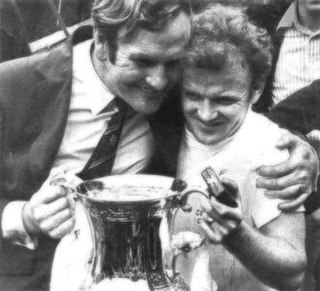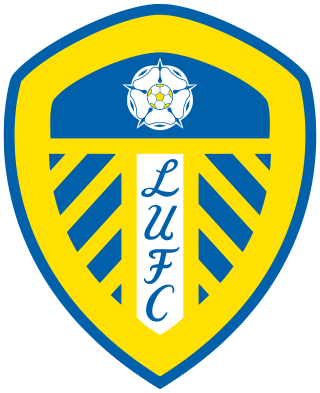Related Research Articles

Forwards are outfield positions in an association football team who play the furthest up the pitch and are therefore most responsible for scoring goals as well as assisting them. As with any attacking player, the role of the forward relies heavily on being able to create space for attack. Their advanced position and limited defensive responsibilities mean forwards normally score more goals on behalf of their team than other players.

Bernhard Carl "Bert" Trautmann EK OBE BVO was a German professional footballer who played as a goalkeeper for Manchester City from 1949 to 1964.
EdwinGray is a Scottish former football player and coach. Gray was a cultured winger, who was an integral member of the legendary Leeds United team of the 1960s and 1970s, later twice becoming the club's manager.

Donald George RevieOBE was an England international footballer and manager, best known for his successful spell with Leeds United from 1961 until 1974, which immediately preceded his appointment as England manager.

Nándor Hidegkuti was a Hungarian football player and manager. He played as a forward or attacking midfielder and spent the majority of his playing career at MTK Hungária FC. During the 1950s he was also a key member of the Hungary national team team known as the Golden Team. Other members of the team included Ferenc Puskás, Zoltán Czibor, Sándor Kocsis and József Bozsik. In 1953, playing as a deep lying centre-forward, a position which has retroactively been compared to the modern false 9 role, he scored a hat-trick for Hungary when they beat England 6–3 at Wembley Stadium. Playing from deep, Hidegkuti was able to distribute the ball to the other attackers and cause considerable confusion to defences. This was an innovation at the time and revolutionised the way the game was played.
On 25 November 1953, Hungary – then the world's number one ranked team, the Olympic champions and on a run of 24 unbeaten games, and England, hailing from the birthplace of football, played a game which became known as the Match of the Century. Hungary won 6–3 and the result led to a review of the training and tactics used by the England team, and adoption of continental practices at international and club level in the English game.
The 1954–55 season was the 75th season of competitive football in England, from August 1954 to May 1955.

Royston James Clarke was a Welsh footballer who played for Cardiff City, Manchester City, Stockport County and Wales as a winger.

Roy Paul was a Welsh professional footballer who played as a half-back for Swansea Town and Manchester City. He also represented the Welsh national team over 30 times and is regarded as one of Wales' best ever players.
Richard Asa Hartford is a Scottish former football player and coach. He started his professional career with West Bromwich Albion. His early progress led to a proposed transfer to Leeds United in November 1971, but this collapsed when a medical examination discovered a heart condition. Hartford instead moved to Manchester City in 1974. He helped City win the 1976 League Cup Final. After a brief spell with Nottingham Forest, Hartford moved to Everton in 1979 and then had a second spell with Manchester City. After playing for Fort Lauderdale Sun, Hartford joined Norwich City. His shot resulted in the only goal of the 1985 League Cup Final.
Septimus Charles "Sep" Smith was an English footballer who played as a creative wing half and originally as an inside forward. Born in Whitburn, County Durham, in 1912, he was the seventh son born in his family, hence the name Septimus.
Les McDowall was a Scottish football player and manager. He managed Manchester City between 1950 and 1963, and then Oldham Athletic until 1965. McDowall was the longest serving manager in Manchester City's history, his tenure spanning 13 years.
William John McAdams was a Northern Irish footballer who played in the inside forward position.
Kenneth Herbert Barnes was an English footballer. He played as a half back for Manchester City and Wrexham. On the books of Birmingham City as a youth, Barnes began his football career at amateur level. Upon completion of his national service in 1947 he joined semi-pro Stafford Rangers.

Leeds United Football Club is a professional football club based in Leeds, West Yorkshire in England. The club play their home matches at Elland Road and compete in the Championship, the second tier of the English football league system.

Fionan "Paddy" Fagan was an Irish footballer who played as a winger.

The 1956 FA Cup final was the final match of the 1955–56 staging of English football's primary cup competition, the Football Association Challenge Cup, better known as the FA Cup. The showpiece event was contested between Manchester City and Birmingham City at Wembley Stadium in London on Saturday 5 May 1956. Two-time winners Manchester City were appearing in their sixth final, whereas Birmingham City were seeking to win the competition for the first time, having lost their only previous final in 1931.
Johnny Williamson was a footballer who played as a forward for Manchester City and Blackburn Rovers in the 1950s.
This page chronicles the history of Manchester City in further detail from 1928 to 1965. See Manchester City F.C. for an overview of the football club.
Hungary v England (1954) was an international football game played on 23 May 1954. The game was played between the Hungary national football team—then the world's number one ranked team and the Olympic champions—and the England national football team, hailing from the birthplace of the game of football and reputed "Kings of Football". The game was a return fixture from the 1953 game in the old Wembley Stadium, where Hungary had beaten England 6–3.
References
- ↑ Smith, Rory (19 February 2014). "A change of formation". ESPN FC. Retrieved 17 June 2020.
- ↑ Hay, Phil; Urquhart, Joe (26 May 2019). "30 years on – Leeds United legend Don Revie remembered in pictures". Yorkshire Evening Post. Retrieved 17 June 2020.
- ↑ "The Revie final: how the Don glowed quietly for Manchester City". The Guardian. 13 May 2011. Retrieved 1 June 2012.